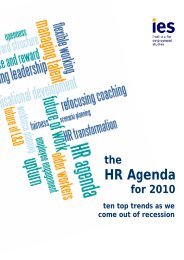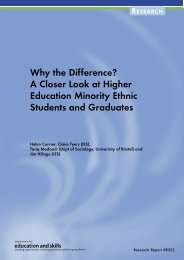PDF of this item - The Institute for Employment Studies
PDF of this item - The Institute for Employment Studies
PDF of this item - The Institute for Employment Studies
You also want an ePaper? Increase the reach of your titles
YUMPU automatically turns print PDFs into web optimized ePapers that Google loves.
Reward and per<strong>for</strong>mance management<br />
In both areas – reward and per<strong>for</strong>mance management – we<br />
continue to undertake assignments on the design and evaluation<br />
<strong>of</strong> systems <strong>for</strong> a wide variety <strong>of</strong> clients. Modernisation is driven by<br />
a number <strong>of</strong> causes: the requirement to demonstrate compliance<br />
with equal pay legislation; the need <strong>for</strong> a better per<strong>for</strong>mance/<br />
reward link; harmonisation <strong>of</strong> terms and conditions across<br />
employee groups; or a change in business circumstances (such as<br />
merger or new market positioning).<br />
For some organisations, the presenting problem is a requirement<br />
<strong>for</strong> greater strategic direction. For others it is to deal with a specific<br />
issue (the difficulty in recruiting and retaining). A third common<br />
cause <strong>of</strong> reward change derives from organisational change<br />
(eg merger or acquisition).<br />
Motivation and well-being<br />
A well-used IES expertise is in seeking to understand employee<br />
satisfaction, attitudes and opinions via surveys. <strong>The</strong>se can be tied<br />
to general measures <strong>of</strong> employee engagement or to specific<br />
questions <strong>of</strong> why people stay or leave organisations. Of late,<br />
employers are expressing particular interest in ‘wellness’ at work.<br />
This can be physical or psychological well-being. Looking at the<br />
consequences <strong>of</strong> unsatisfactory engagement or ill health, we have<br />
undertaken several projects recently on absence at work – the<br />
causes and solutions.<br />
Work in <strong>this</strong> area aims to examine issues both from the employee<br />
perspective and from the employer viewpoint. <strong>The</strong> connection<br />
between the two has now been demonstrated.<br />
HR functional excellence<br />
<strong>The</strong> HR function has undergone significant change in recent years.<br />
Many organisations have reorganised HR, redesigned processes<br />
and automated activities where possible. We executed a number<br />
<strong>of</strong> research projects in <strong>this</strong> area during the year, looking at new HR<br />
structures or roles and development issues <strong>for</strong> HR pr<strong>of</strong>essionals.<br />
We have examined these topics generally as well as in specific<br />
sectors. This knowledge has been applied to advisory work on<br />
designing HR structures, understanding HR capability and<br />
customer opinion, and in developing business partners.<br />
HOW WE OPERATE<br />
Through its work <strong>for</strong> employers, IES <strong>of</strong>fers the link between<br />
research and consultancy. We aim to learn from our research and<br />
apply it in our consultancy, and vice versa.<br />
Corporate members <strong>of</strong> the IES HR Network (see page 12) also<br />
have the opportunity to shape and participate in the research, and<br />
to receive the results at member events. Research projects funded<br />
through the HR Network during the year have covered the<br />
effectiveness <strong>of</strong> individual per<strong>for</strong>mance-related pay and the<br />
customer view <strong>of</strong> HR. Also <strong>for</strong> HR Network members, we are<br />
continuing our action learning set on human capital metrics, and<br />
we have started a project looking at older workers in employment.<br />
Publications stemming from HR Network research during the year<br />
have included a range <strong>of</strong> IES reports (eg on coaching), papers (eg<br />
on mental health at work) and opinion pieces (eg on assessment<br />
processes).<br />
Our project work <strong>for</strong> employer clients is <strong>of</strong> two main types: some<br />
projects extend the research we do <strong>for</strong> corporate members <strong>of</strong> the<br />
HR Network; others apply it in practical settings through<br />
consultancy assignments. Our work, <strong>for</strong> example, on the HR<br />
function led to carrying out research <strong>for</strong> CIPD on how changing<br />
organisational structures might impact on career paths and<br />
development opportunities. This was published as Managing and<br />
Developing HR Careers: Emerging Trends and Issues. Another<br />
project <strong>for</strong> CIPD focused on the impact <strong>of</strong> HR trans<strong>for</strong>mation on<br />
the structure, processes and staffing <strong>of</strong> organisations. <strong>The</strong> initial<br />
findings were presented in a CIPD report <strong>The</strong> Changing HR<br />
Function: <strong>The</strong> Key Questions and the final report is being<br />
published in November 2007 by CIPD as <strong>The</strong> Changing HR<br />
Function: Trans<strong>for</strong>ming HR. Another project <strong>for</strong> the National<br />
Health Service Improvement and Innovation Agency is featured<br />
opposite.<br />
10 IESAnnualReview2007

















